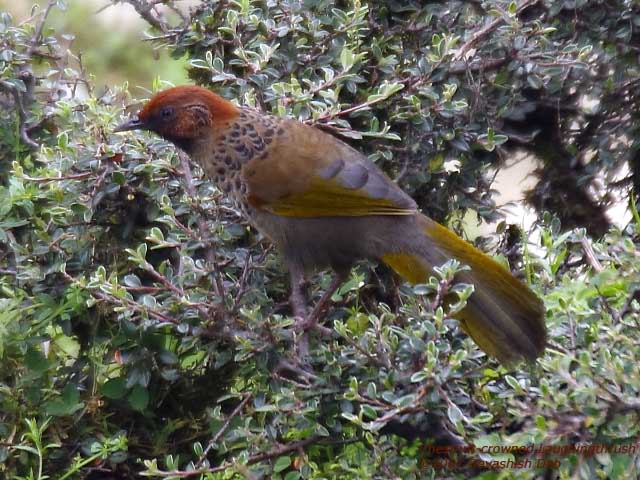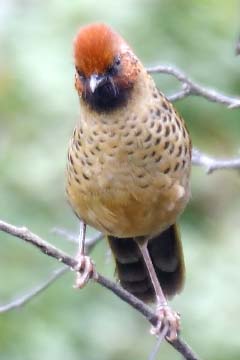|
|
| Chestnut-crowned
Laughingthrush |
Garrulax
erythrocephalus |
| 3
December 2009 |
|
Possible
regional races (polytypic)
|
|
|
-G. e. kali; Vaurie, 1953
|
|
|
-G. e. nigrimentum; Oates, 1889
|
|
|
-G. e. erythrocephalus; Vigors, 1832
|
|
Garrulax
erythrocephalus erythrocephalus |
|
|
|
Historical
Pls use the mousewheel to zoom in/out (Max 2X)
 Dugalbetta, near Chopta, Uttaranchal, India 24 June 2007 A couple was seen together 82. Trochalopterum erythrocephalum. The Red-headed Laughing-Thrush. Cinclosoma erythrocephalum, Vigors, P.Z.S. 1831, p. 171; Gould, Cent. pl. 17. Garrulax erythrocephalus ( Vig.) Blyth, Cat. p. 97. Pterocyclus erythrocephalus ( Vig.) Horsf. & M. Cat. i, p. 206. Trochalopteron erythrocephalum ( Vig.), Jerd. B.I. ii, p. 43; Stoliczka, J.A.S.B. xxxvii, pt. ii, p. 37; Hume, N.&E. p. 258; id. Cat. no. 415; Scully, S.F. viii, p. 290; Sharpe, Cat. B. M. vii, p. 360; Oates in Hume's N.&E. 2nd ed. i, p. 55. Coloration: Forehead, crown, and nape chestnut; ear-coverts chestnut, each feather blackish near the tip and edged with white; lores, chin, and upper throat black with a chocolate tinge; cheeks mingled chestnut and black; mantle and sides of neck olive-brown, each feather with a semicircular black mark near the end; lower back plain olive-brown; rump and upper tail-coverts slaty grey; tail ashy, suffused with golden yellow on the outer webs; wingcoverts olive-brown, the greater series broadly tipped with deep ferruginous; primary-coverts and winglet yellow  on
the outer webs, ashy on the inner; outer webs of the primaries and
secondaries bright golden yellow; tertiaries and tips of the secondaries
ashy blue; the base of the outer webs of the secondaries golden
red; lower plumage pale fulvous, washed with olivaceous on the sides
of the body and under tail-coverts, each feather of the throat and
breast with a narrow crescentic black bar near the end and tipped
with fulvous white. on
the outer webs, ashy on the inner; outer webs of the primaries and
secondaries bright golden yellow; tertiaries and tips of the secondaries
ashy blue; the base of the outer webs of the secondaries golden
red; lower plumage pale fulvous, washed with olivaceous on the sides
of the body and under tail-coverts, each feather of the throat and
breast with a narrow crescentic black bar near the end and tipped
with fulvous white.The young are at first without the black marks on the throat, breast, and back, but they soon acquire them. Legs and feet pale brown; iris pale yellowish brown; bill black (Hume); iris greyish brown (Scully). Length nearly 11; tail 4.8; wing 4.2; tarsus 1.5; bill from gape 1.1. Habits: Scully remarks that this species moves about very rapidly and noiselessly amongst bushes, and its note is subdued and not unmusical. It breeds from May to July, constructing a nest of dead leaves bound together with ferns and grass in a low tree or bush, and laying from two to four eggs, which are blue marked with brownish red and measure 1.2 by 0.82. |
About/Terms
of use etc. in the home page
Copyright ©
2006-2009 birdpoints. All rights reserved.